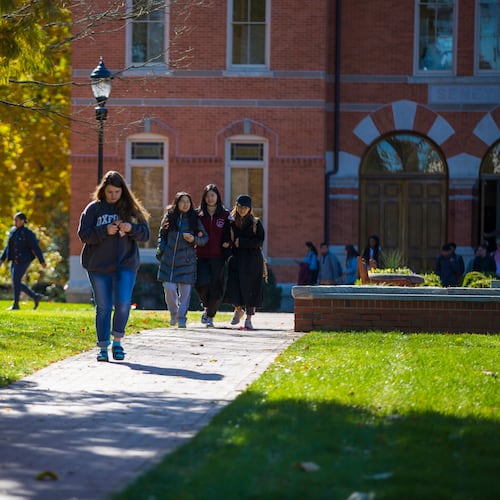Georgia State University had a problem a decade ago. Just one-third of its students were graduating, and the percentage was even lower for African-Americans, a growing part of its enrollment.
Administrators, faculty and staff worked on improving student outcomes by requiring students to take math and English courses in their first year as well as courses that align with majors they’re considering.
The university’s six-year graduation rate is now 55 percent, and three percentage points higher for African-Americans, said Timothy Renick, Georgia State’s senior vice president for student success.
State officials are employing a similar strategy throughout the University System of Georgia, which has had record enrollment for the fourth consecutive year. Their thinking: If students are engaged in potential majors earlier in their academic careers, they’ll do better in school, graduate sooner with less debt and find good-paying jobs. The effort is called “momentum year.”
“This is fundamental change,” said Tristan Denley, the University System’s chief academic officer. “These are powerful changes.”
University System data show some of its schools need changes to help students. Eight schools in the system have six-year graduation rates below 40 percent. The national six-year college graduation rate is 60 percent, according to federal government data.
In addition to the math and English course requirements, students must have at least nine credit hours in a focus area or major.
Momentum year is fundamental change indeed. Many students arrive at college unsure what they want to do or study. One-third of students change their majors once and one in 10 change their majors twice, according to federal government data.
System leaders believe such change, or “choice paralysis” as Denley labeled it, is not good and cite data for their argument for taking courses in what they describe as “meta-majors.” University System students are 10 times more likely to graduate if they pass foundational English and math courses that are linked to potential majors, officials say.
Georgia State’s numbers improved, in part, due to hiring more counselors to advise students. The university, with nearly 53,000 students, has the highest enrollment in the state and one of the largest budgets in the system. Lack of such resources can be a problem for smaller colleges, said Angela Boatman, an assistant professor of public policy and higher education at the Peabody College at Vanderbilt University in Tennessee.
“If (the school) is resource-constrained and the college cannot afford that, that’s where you see students struggling,” she said.
The public college system in Tennessee, where Denley previously worked as vice chancellor for academic affairs for the Tennessee Board of Regents, has been lauded by educators for efforts to help students succeed in community college. The probability of attaining a degree increased from 38 to 57 percent, officials say. Tennessee leaders say the next steps include helping students from rural and low-income communities, where degree-attainment rates are slightly behind.
“That’s the challenge of policies like this,” she said: “ensuring students with certain life circumstances are not penalized for not completing the 15 credits.”
Georgia officials say momentum year offers some flexibility. The University System consolidated several schools in recent years, and Denley suggested those colleges and universities can use some of the savings from the mergers for extra counselors and other services to support students through momentum year.
Georgia State’s Renick said the average student there is completing a degree a half-semester sooner than five years ago. Students fill out questionnaires designed to make them think about potential careers. Workers in those careers visit to describe what it’s like in those professions.
Georgia State still has work to do, Renick said. Administrators want to increase the percentage of students who stay after the first year at its Perimeter campus. Many of those students need more remedial help, he said. Renick said they’re looking to improve retention rates through a $20 million grant State Farm gave the university and local schools in 2017 to help students complete their degrees. State Farm added $1.5 million for the program in November.
At Gordon State College in Barnesville, one of the smaller schools in the system, officials say they’re already seeing positive results. They say 61 percent of first-year students are taking 15 or more credits this semester, twice the percentage of prior years. The percentage of those students choosing “general studies” as their academic pathway has declined by 37 percent from the prior fall semester.
First-year Gordon State student Kenya Brown said during a presentation to the state’s Board of Regents in November that the extra staff support and push to make her consider a pathway — nursing — have eased her college transition. Brown, a first-generation college student from Newton County, learned about tutoring and internship opportunities and met study partners during orientation. Her voice cracked with emotion as she discussed being asked to be a senator in the college’s student government association.
She learned a lesson about herself and college that the University System hopes will become the story for more students.
“I can become completely engaged with college from the beginning,” Brown said.
About the Author
Keep Reading
The Latest
Featured



